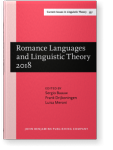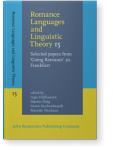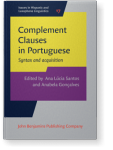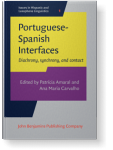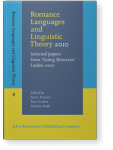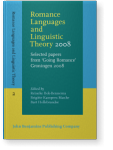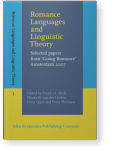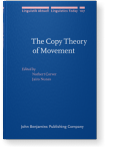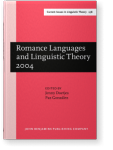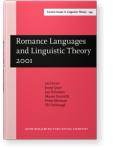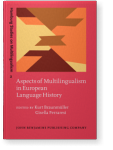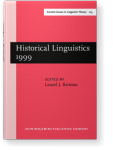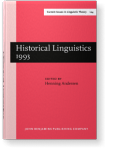Ana Maria Martins
List of John Benjamins publications for which Ana Maria Martins plays a role.
2021 Chapter 9. Brazilian and European Portuguese and Holmberg’s 2005 typology of null subject languages Romance Languages and Linguistic Theory 2018: Selected papers from 'Going Romance' 32, Utrecht, Drijkoningen, Frank, Sergio Baauw and Luisa Meroni (eds.), pp. 171–190 | Chapter
This paper rethinks Holmberg’s (2005) characterization of partial vs. consistent null subject languages (NSL) based on data from Brazilian and European Portuguese, the former a partial, the latter a consistent NSL. The paper proposes that rather than overt morphological distinctions, what is… read more
2019 Chapter 1. Against V2 as a general property of Old Romance languages Romance Languages and Linguistic Theory 15: Selected papers from 'Going Romance' 30, Frankfurt, Feldhausen, Ingo, Martin Elsig, Imme Kuchenbrandt and Mareike Neuhaus (eds.), pp. 9–33 | Chapter
This paper revisits the hypothesis that the verb-second property was a shared feature of the Old Romance languages by investigating Old Portuguese. It demonstrates, on the basis of positive empirical evidence, that Old Portuguese allowed clausal configurations that could not have been derived by a… read more
2018 Infinitival complements of causative/perception verbs in a diachronic perspective Complement Clauses in Portuguese: Syntax and acquisition, Santos, Ana Lúcia and Anabela Gonçalves (eds.), pp. 101–128 | Chapter
This paper traces the diachrony of three alternative configurations of infinitival complementation with causative and perception verbs in Portuguese, namely the faire-infinitive, the Exceptional Case Marking and the inflected infinitive constructions. It is shown that the faire-infinitive… read more
2014 Syntactic change in Portuguese and Spanish: Divergent and parallel patterns of linguistic splitting Portuguese-Spanish Interfaces: Diachrony, synchrony, and contact, Amaral, Patrícia and Ana Maria Carvalho (eds.), pp. 35–64 | Article
This chapter describes two cases of divergent syntactic change between Portuguese and Spanish, namely clitic placement and post-nominal algum/alguno. While both changes feature instances of linguistic splitting from a former unity during the Middle Ages, they nevertheless exhibit different patterns… read more
2012 VP Ellipsis: New evidence from Capeverdean Romance Languages and Linguistic Theory 2010: Selected papers from 'Going Romance' Leiden 2010, Franco, Irene, Sara Lusini and Andrés Saab (eds.), pp. 155–176 | Article
Capeverdean, a Portuguese-based Creole language, displays an intriguing pattern of VP Ellipsis (VPE): VPE may occur in answers to yes/no questions but it is ruled out in coordination structures. This is unexpected, since both polar question/answer pairs and coordination structures are typical… read more
2010 Middle scrambling with deictic locatives in European Portuguese Romance Languages and Linguistic Theory 2008: Selected papers from 'Going Romance' Groningen 2008, Bok-Bennema, Reineke, Brigitte Kampers-Manhe and Bart Hollebrandse (eds.), pp. 59–76 | Article
This paper discusses the peculiar ability of certain deictic locatives (like lá ‘there’) to appear left-adjacent to the verb in European Portuguese. We propose that leftward movement of lá (and similar deictic locatives) is middle scrambling, understood as movement to Spec,TP. In order to explain… read more
2009 Subject doubling in European Portuguese dialects: The role of impersonal se Romance Languages and Linguistic Theory: Selected papers from ‘Going Romance’ Amsterdam 2007, Aboh, Enoch O., Elisabeth van der Linden, Josep Quer and Petra Sleeman (eds.), pp. 179–200 | Article
This paper discusses a subject doubling construction found in European Portuguese dialects where the impersonal clitic se is doubled by a strong pronoun/DP. The availability of subject doubling is explained under the hypothesis that dialectal se escapes the Case filter because it is .-incomplete… read more
2007 Double realization of verbal copies in European Portuguese emphatic affirmation The Copy Theory of Movement, Corver, Norbert and Jairo Nunes (eds.), pp. 77–118 | Chapter
This chapter discusses European Portuguese sentences where a finite verb occurs twice. Such sentences express emphatic affirmation and are either elliptic structures produced as replies to a yes/no question presupposing a negative answer or full declaratives which contradict a preceding negative… read more
2006
Aspects of Infinitival Constructions in the History of Portuguese
Historical Romance Linguistics: Retrospective and perspectives, Gess, Randall and Deborah Arteaga (eds.), pp. 327–355 | Chapter2006 Emphatic Affirmation and Polarity: Contrasting European Portuguese With Brazilian Portuguese, Spanish, Catalan and Galician Romance Languages and Linguistic Theory 2004: Selected papers from ‘Going Romance’, Leiden, 9–11 December 2004, Doetjes, Jenny and Paz González (eds.), pp. 197–223 | Article
2003 Deficient Pronouns and Linguistic Change in Portuguese and Spanish Romance Languages and Linguistic Theory 2001: Selected papers from 'Going Romance', Amsterdam, 6–8 December 2001, Quer, Josep, Jan Schroten, Mauro Scorretti, Petra Sleeman and Els Verheugd-Daatzelaar (eds.), pp. 213–230 | Article
2003 From unity to diversity in Romance syntax: Portuguese and Spanish Aspects of Multilingualism in European Language History, Braunmüller, Kurt and Gisella Ferraresi (eds.), pp. 201–233 | Article
1995 Clitic placement from Old to Modern European Portuguese Historical Linguistics 1993: Selected papers from the 11th International Conference on Historical Linguistics, Los Angeles, 16–20 August 1993, Andersen, Henning (ed.), pp. 295–308 | Article
